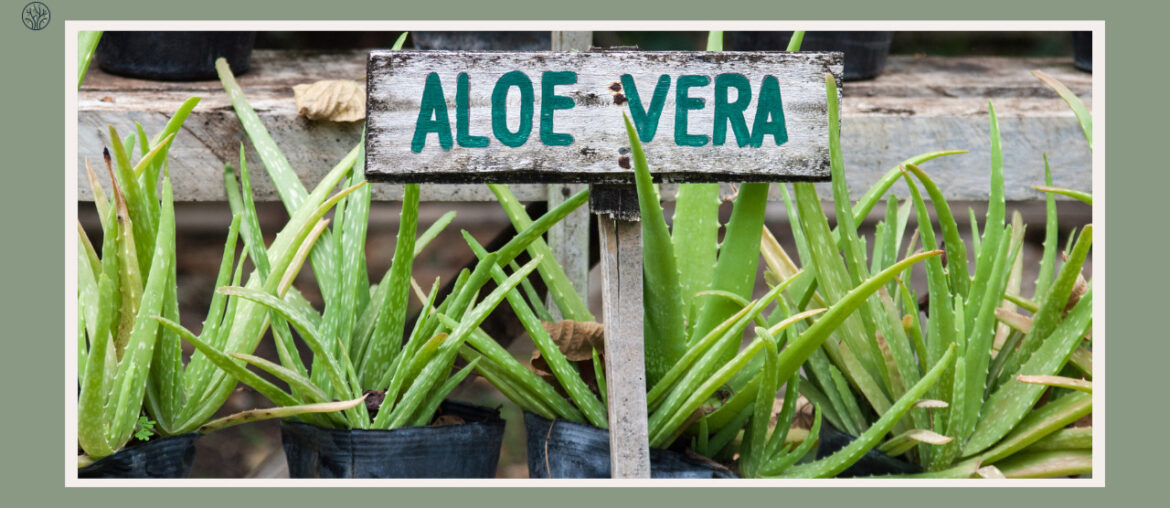Imagine a green plant that can survive in harsh, and dry conditions. You might think of a cactus. But there is another green succulent that is also adapted to dry and arid environments: the aloe. This leaves us wondering Is aloe vera a cactus?
Surprisingly, the answer is no. Aloe vera is not a cactus and is more closely related to tulips than to cacti. How can that be? In this blog post, we will explore the similarities and differences between aloe vera and cacti, and explain why they are often confused. We will also look at some of the benefits and uses of these amazing plants, and how you can grow them at home.
Key takeaways
- Aloe vera and cacti are both succulents, but they are not the same.
- Cactus and aloe vera have different appearances, growth patterns, and flowering habits.
- Aloe vera is a versatile plant that has many uses. It can help improve your health, and appearance and can also be used in many dishes.
- Both plants love well-draining soil, warm temperatures, enough sunlight, and infrequent, deep watering.
Aloe Vera Vs Cactus: Key Differences
Let’s first explore the similarities and differences between aloe vera and cacti.
Appearance
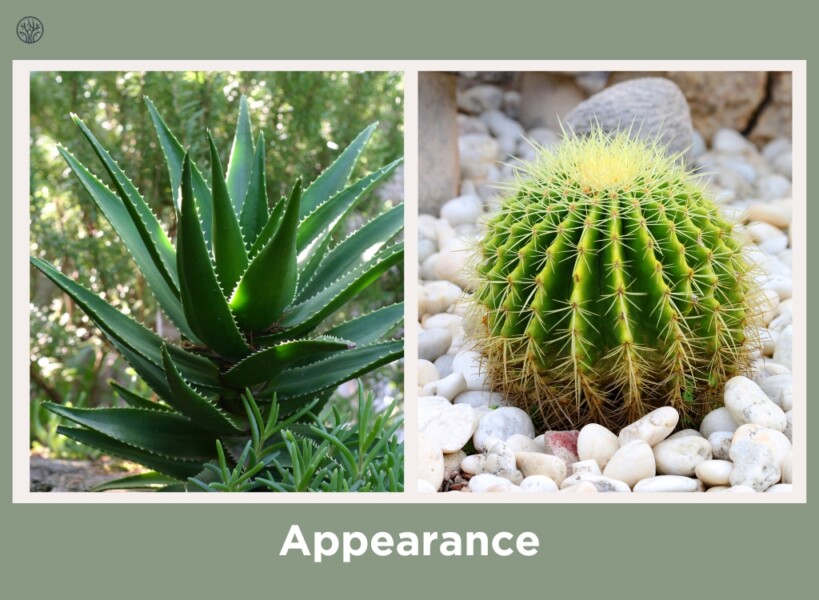
Aloe vera plants have thick, fleshy, and usually green leaves that grow in a circular pattern, forming a rosette. The leaves are smooth and often have sharp edges. Aloe vera plants are usually small and compact, unlike most cacti.
In contrast, cacti have many different shapes and sizes, ranging from round green balls to tall columns to flat pads. The most distinctive feature of cacti is their spines, which are actually modified leaves. Cacti look more rough and tough and can grow much bigger than Aloe vera plants.
Leaves
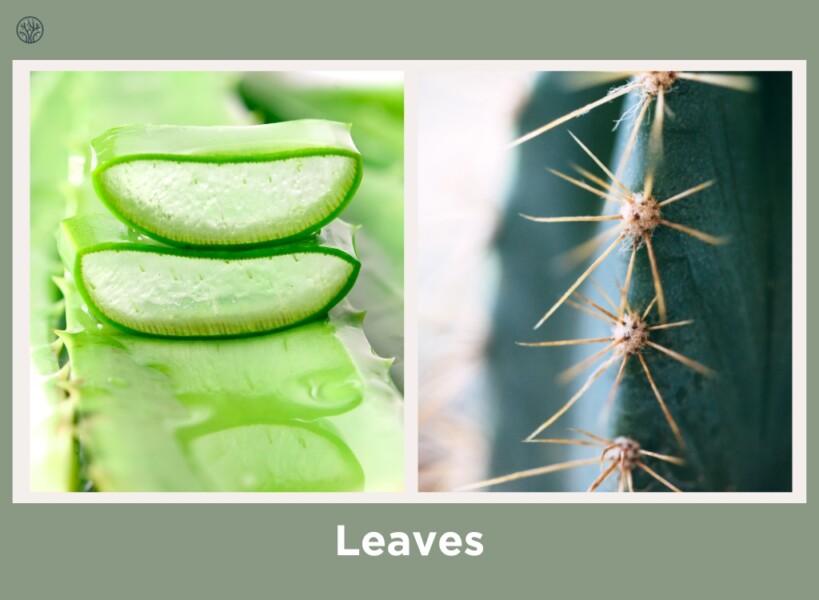
Aloe vera’s leaves are thick, fleshy, and filled with a gel-like substance. The leaves are usually green, sometimes with a hint of blue, and have small teeth or serrations along the edges. The fleshy leaves’ purpose is to store water, helping the plant survive in dry conditions.
On the other hand, most cacti do not have traditional leaves. Instead, they have spines or scales, which are actually modified leaves. These spines help reduce water loss and protect the cactus from predators.
Stems
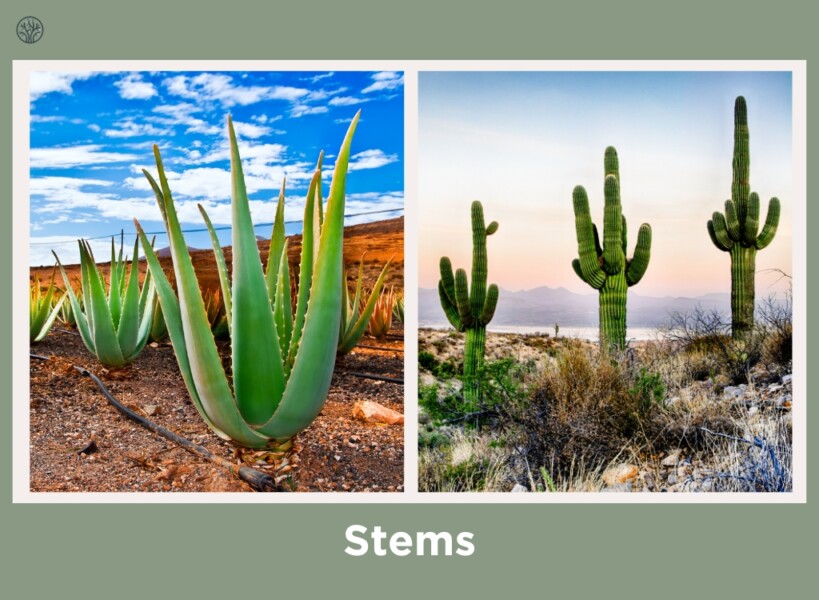
Aloe vera plants typically have short stems or are stemless, with leaves growing directly from the plant’s base. The stem, when present, is usually hidden within the base of the leaves. Aloe plants often grow in clusters, with new rosettes forming from the base of the plant.
Cacti, on the other hand, have noticeable stems, which can have different shapes and sizes. The stems can be tall and columnar, round, or flat and paddle-like, depending on the type of cactus. These stems are the primary site for photosynthesis and water storage, making up for the lack of traditional leaves.
Flowers
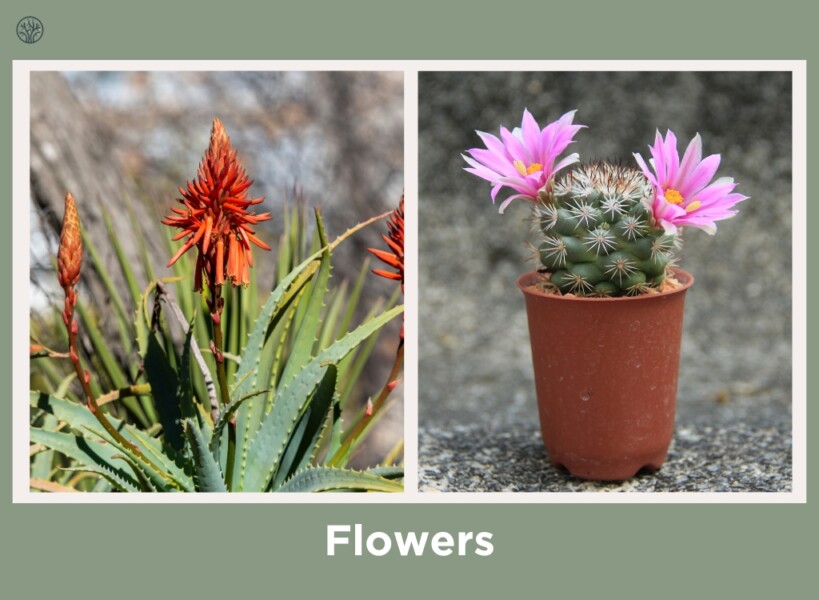
Aloe vera typically has flowers that grow on tall spikes from the middle of the rosette. These flowers are usually tube-shaped and have bright colors like red, orange, or yellow. They tend to bloom in warmer months, attracting birds and bees for pollination. The blooming period for Aloe vera can last several weeks.
In contrast, cacti have many different kinds of flowers and colors, from whites and yellows to pinks and reds. The flowers often grow directly from the stem and can be very large and beautiful. The flowers of cacti have different blooming seasons and pollinators, depending on the type of cactus, with some flowers lasting only a day or two.
To wrap up our discussion, let’s look at a table that summarizes the main differences between aloe vera and cacti:
| Aspect | Aloe vera | Cacti |
| Appearance | Rosette growth pattern, thick and fleshy leaves, generally smaller in size. | Variety of shapes, prominent spines, ribbed or smooth stems, often larger. |
| Leaves | Thick, fleshy, and smooth, with serrated edges | Spines or scales instead of traditional leaves. |
| Stems | Short or stemless, leaves grow from the base. | Prominent stems, with various shapes and sizes |
| Flowers | Tubular flowers on tall spikes, usually red, orange, or yellow | Various types and colors of flowers, often large and showy |
| Blooming season | Warmer months, lasting several weeks | Varies among species, some lasting only a day or two |
| Pollinators | Birds and bees | Depends on the type of flower |
Benefits And Uses Of Aloe Vera
Aloe is a plant with many benefits and uses that you can apply to almost any aspect of your life.
Health
Aloe vera is a powerhouse of health benefits. Its gel, rich in vitamins, minerals, and antioxidants, is known for:
- Digestive Aid: Aloe vera juice can soothe digestive issues and improve gut health.
- Immune Booster: The plant is packed with immune-boosting polysaccharides and antioxidants.
- Blood Sugar Regulation: Some studies suggest that Aloe vera can help stabilize blood sugar levels, beneficial for those with diabetes.
- Skin Healing: Its anti-inflammatory and antimicrobial properties make it effective for wound healing and skin repair.
Cosmetic

Aloe vera is a common ingredient in many cosmetic products. It can nourish and rejuvenate your skin and hair like no other.
- Skin Care: Aloe vera gel is a wonderful moisturizer, known for soothing skin irritations and hydrating dry skin. It can also help with acne, sunburn, and eczema. You can apply it directly to your skin or mix it with other ingredients, such as honey, lemon, or yogurt, for a homemade mask.
- Hair Care: It can also help with dandruff, hair growth, and frizz. You can use it in shampoos and conditioners, or make your own hair gel by mixing it with water and a few drops of your favorite essential oil.
- Anti-aging: The gel’s antioxidants can help combat signs of aging, keeping your skin supple and youthful. Its antioxidants can protect your skin from free radicals and environmental damage.
Home And Garden
Aloe vera is not only for personal care; it’s also a great addition to your home and garden. Why is that?
- Air Purification: Aloe vera can help purify the air of common household toxins. It can also improve the humidity and oxygen levels in your home.
- Easy Care Plant: As a low-maintenance succulent, perfect for busy or novice gardeners. It doesn’t need much water or fertilizer and can tolerate a range of light and temperature conditions.
- Natural Remedies: You can use aloe vera gel can be used for homemade skincare remedies, offering a natural alternative to store-bought products. You can use it to treat burns, cuts, insect bites, rashes, and more.
Culinary
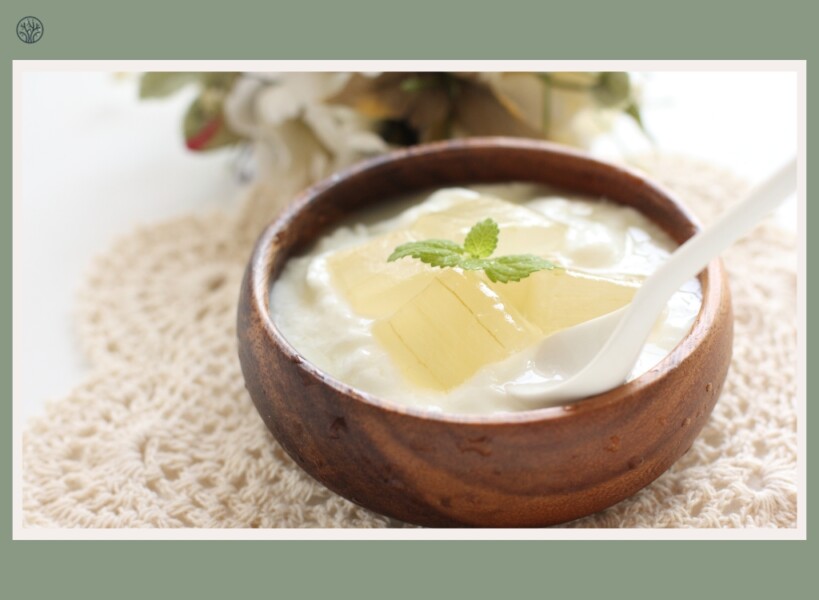
Aloe vera is not just a plant; it’s also a food. Yes, you heard that right. You can eat Aloe vera and enjoy its health and flavor benefits.
- Beverages: Aloe vera juice is a refreshing and healthful drink, often incorporated into smoothies. You can make your own Aloe vera juice by blending the gel with water and some sweetener, such as honey or agave nectar.
- Edible Ingredient: The gel can be used in salads and other dishes, adding a unique texture and health benefits. You can peel the skin off the Aloe vera leaf and cut the gel into small pieces, then toss it with some dressing, greens, and nuts for a simple salad.
- Flavor Enhancer: Its mild, slightly bitter taste can add an interesting flavor profile to various recipes. It can complement sweet, sour, or spicy flavors, and create a balance in your dish. You can use it in sauces, dips, marinades, or desserts, and experiment with different combinations.
Caring For Aloe Vera And Cacti
Both Aloe vera and cacti are hardy plants that can survive in harsh conditions. But that doesn’t mean they don’t need proper care.
Watering
- Aloe vera: Aloe vera likes deep but infrequent watering. Let the soil dry out completely before watering again. Too much water can cause root rot, so make sure the pot has good drainage. In winter, water less as the plant goes dormant.
- Cacti: Cacti need even less water than Aloe vera. They store water in their stems, so they can handle dry environments. Water cacti sparingly, only when the soil is bone dry. This might mean watering once a month or less, especially in cooler months. Avoid watering the cactus itself, as this can lead to rot.
Sunlight
- Aloe vera: Aloe vera loves bright, indirect sunlight. Direct sunlight can be too harsh, causing the leaves to turn brown. A south or west-facing window is ideal, as it provides enough light without the intensity of midday sun. If the plant doesn’t get enough light, you can also use grow lights to aid growth.
- Cacti: Cacti, on the other hand, prefer more direct sunlight. They are happy on sunny windowsills where they can get several hours of sunlight each day. However, some cacti may need partial shade, especially during the hottest part of the day, to prevent sunburn. Rotate the plant occasionally to ensure even exposure to sunlight and balanced growth.
Temperature
- Aloe vera: Aloe vera likes warmer temperatures, usually between 55°F to 80°F (13°C to 27°C). It doesn’t like cold and should be protected from frost. If you live in a cold climate, keep Aloe vera indoors during the winter. Avoid sudden temperature changes, as this can stress the plant. Don’t place it near drafty windows or heating vents.
- Cacti: Cacti can tolerate higher temperatures and can thrive in conditions up to 90°F (32°C) or higher. Like Aloe vera, most cacti are not frost-tolerant and should be kept above 50°F (10°C).
Soil
- Aloe vera: Aloe vera needs well-draining soil to prevent waterlogging. A mix designed for succulents or cacti is ideal. You can also make your own mix by combining potting soil with sand or perlite. Make sure the pot has drainage holes to avoid excess water.
- Cacti: Cacti also need well-draining soil, maybe even more so than Aloe vera. A commercial cactus mix is usually suitable. You can also add coarse sand or fine gravel to the mix for better drainage. Good aeration in the soil is key to preventing root rot and other moisture-related issues.
FAQs
Are all cacti succulents?
Yes, all cacti are succulents, but not all succulents are cacti. This is a common point of confusion. Succulents are a broad group of plants that store water in their leaves, stems, or roots. Cacti belong to this group and have unique adaptations, such as spines and areoles (specialized structures from which spines or flowers grow).
Are aloe and cactus plants toxic to pets?
Yes, Aloe vera can be toxic to pets. If ingested, it can cause vomiting, diarrhea, and lethargy in animals like cats and dogs. While many cacti are not toxic, their spines can cause physical injuries. It’s always best to research the specific type of cactus you have and keep it out of reach of pets.
How often should I repot my aloe and cactus plants?
Aloe Vera and cacti should generally be repotted every two to three years, or when they outgrow their current pot. You can tell when this happens when roots start to crowd or come out of the drainage holes. Repotting provides fresh nutrients and more space for continued growth.
Why are my aloe leaves turning brown and mushy?
Brown and mushy leaves in Aloe Vera are often signs of overwatering. This can lead to root rot, a common issue in succulents. Make sure the soil is well-draining and let it dry out completely between waterings. Reducing the frequency of watering can help remedy this issue.
Should I remove the spines from my cactus plant?
No, it’s not advisable to remove the spines from a cactus. The spines play a crucial role in the plant’s survival, providing protection from predators and reducing water loss. Removing them can harm the cactus and leave it vulnerable to diseases.
Can aloe vera and cacti coexist in the same pot?
While it’s possible for Aloe Vera and cacti to coexist in the same pot, it’s not ideal due to their different watering needs. Aloe Vera typically requires more frequent watering than cacti. Planting them together can make it challenging to meet their individual care requirements without compromising the health of one or the other.

